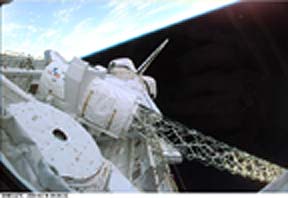
It may come as a surprise
to most who've never worked on or utilized topographic data sets or maps to
learn that much of the global land surface (as well as parts of ocean floors)
has not been mapped at other than coarse (large value) contour intervals. Better
maps at closer intervals are very much needed in many enterprises, both civilian
and military. It should come as no surprise, then, that topographic mapping
from satellites can overcome this deficiency since polar orbiters and Shuttle
missions pass over much of the land masses of the World. Experience with radar
mapping from the Shuttle led geographers, cartographers, and other specialists
to advocate a mission that could systematically map large regional terrains
in need of more detailed elevation data for the land. Such a mission, covering
both well- and poorly-mapped surfaces, would provide a uniform and coherent
data set that would serve as a database suited to many applications.
The response from the U.S. community, through NASA and joined by a German organization, is the Shuttle Radar Topography Mission, which was successfully launched (Mission STS-99, Shuttle Endeavor) on February 11, 2000 and operated for 10 days, gathering data that covers approximately 80% of the land surface. It will take about 2 years to fully reduce all data and provide topographic maps in various formats. C-band and X-band radars (see page 8-1 for wavelengths) operate from one pair of transmission-receiving antennas in the Shuttle payload bay and a matching second pair (receiving only) at the end of a collapsible boom of 60 m length (actual distance between inboard and outboard antennas is 83 m), so that dual signal return simulates the separation needed to provide parallax-like data. Here is a view of the boom (right) center as it was extended during the mission.

NASA JPL supplied the C-band instrument pair. The data from 159 orbits (at angles to the equator that allow monitoring the Earth between 65° N and 50° S), at a Shuttle altitude nominally at 233 km (145 miles), extend for each pass over a swath width of 225 km (141 miles), so that continuous operation for 10 days provided nearly total coverage (with some duplication) of the land traversed. Under these conditions, the radar image has a ground resolution of 30 x 30 m and a vertical (elevation) resolution of 16 m (absolute) and 10 m (relative).
Processing the data into a stereo-mode which, through the principle of interferometry, can be converted into elevation differences and then restructured as a DEM data set by incorporating bench marks (known elevation points), is summarized in this diagram (somewhat degraded by low Internet resolution):
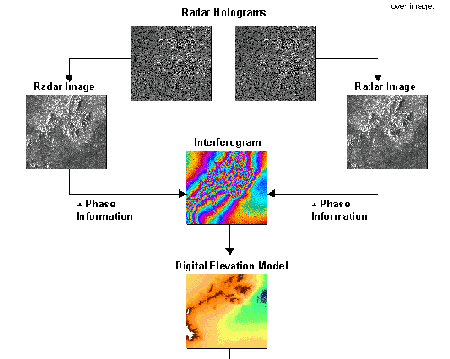
In essence, radar holograms from both antennas are generated (and can be converted to images). Then, while still in digital mode, these utilize phase information to construct interferograms (again, displayable as images). After introducing known elevation points to the data set, a digital height model (DEM type) can then be used to contruct a relief or shaded relief image. That can be combined with other data types (e.g., Landsat imagery) or converted to other map forms.
Let us look at a typical C-band image, of an area covering part of Dallas, Texas:
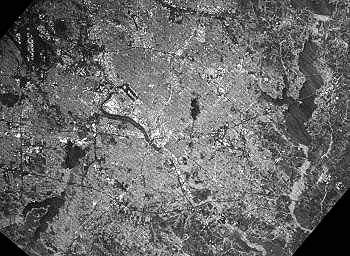
Next, examine this interferogram that shows the distinctive color banding such a data type presents. The two islands are West Maui and Lanai in the Hawaiian chain. Each cycle of colors (from pink to blue to pink) passes through an equal amount of elevation difference (400 m [1300]) in a manner similar to broad contour lines.
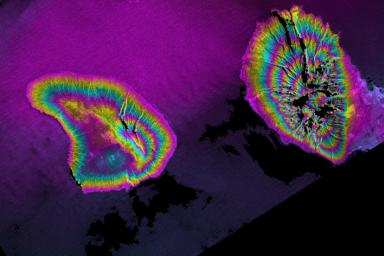
One of the practical uses of SRTM data resides in the monitoring of changes of elevation over time. This can be important as a tool for observing the swelling of a volcano with newly emplaced lavas. This causes the volcanic edifice to undergo upward swelling of the surface. This next illustration shows changes in the surface in and around the Three Sisters, volcanic stratocones in the Oregon Cascades near Bend, OR. To construct the change plot, data from several collection times over an extended period are used.
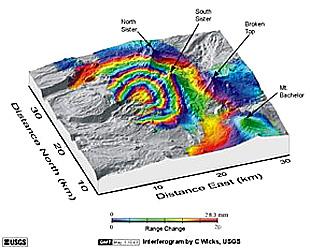
To illustrate some of the different image types derivable from SRTM data, we will display coverage of a pass across the Kamchatka Peninsula, a volcanic mountain chain in eastern Siberia. The first view is the interferogram whose color fringes suggest relief.
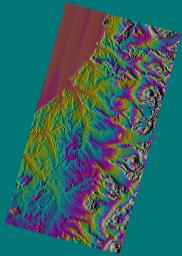
From that, a shaded relief (computer-generated artificial light imposes a pattern of shadow and light) and a shaded relief perspective view are derived:
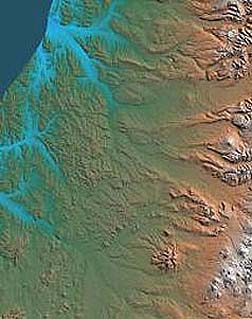
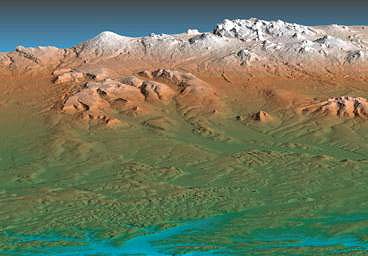
When SRTM data are combined with Landsat, these views of the Kamchatka mountains ensue:
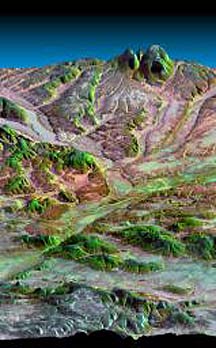
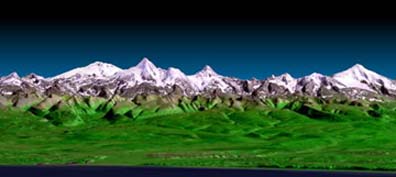
Still another SRTM example from the same part of the World is Hokkaido Island in Japan, with its active volcano, USU.
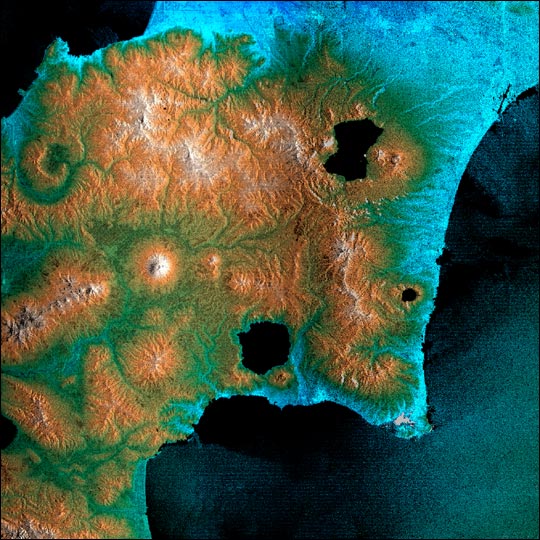
A special type of stereo image known as an analglyph is made by projecting one of the image pair through red and the other through blue filters to give the resulting superimposed image. To see relief in stereo, for this segment of the Kamchatka peninsula, a pair of glasses made usually of cardboard with the right eye opening covered by red cellophane and the left with blue are needed. A few users of this Tutorial may have one from a 3-D movie experience or can make the glasses in the obvious way.
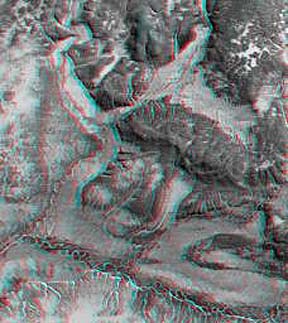
The X-band radar on SRTM is provided and managed by DLR - the Deutches Fernerkundungs-datenzentrum (the German Aerospace Center). Its antenna setup is similar to JPL's C-band system, the difference being that the antenna in the Shuttle Bay is fixed to look straight down, rather than inclined. Thus its swath width is 50 km. Data processing to produce elevation maps is essentially the same. Here is an X-band image of part of the Kamchatka Peninsula; the highest point in the mountains is 4755 m (15690 ft):
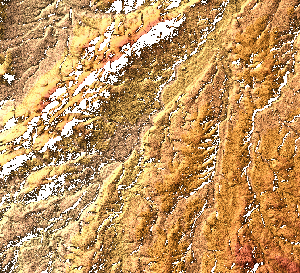
For those interested in additional information and updates and more imagery, tie into the JPL and German Aerospace SRTM Web sites.
How much of an improvement in small-scale map quality in those parts of Earth where topographic maps are lacking in details found in, say, coverage of the United States? This next image is convincing: on the left is a colorized map of the Uatuma River Basin near Manaus in eastern Brazil based on the best elevation data available; on the right is a SRTM image processed to display the optimum topographic representation extractable from the radar data. The black areas in the map on the right depict the water buildup in Lake Balbina created by damming the river.
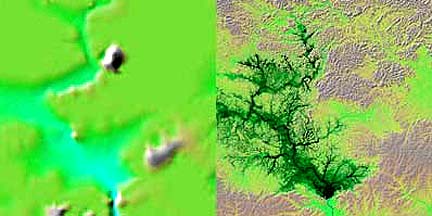
Follow-up programs are "in the works" to use radar interferometry and laser profiling to continually upgrade topographic/elevation mapping of the entire world.